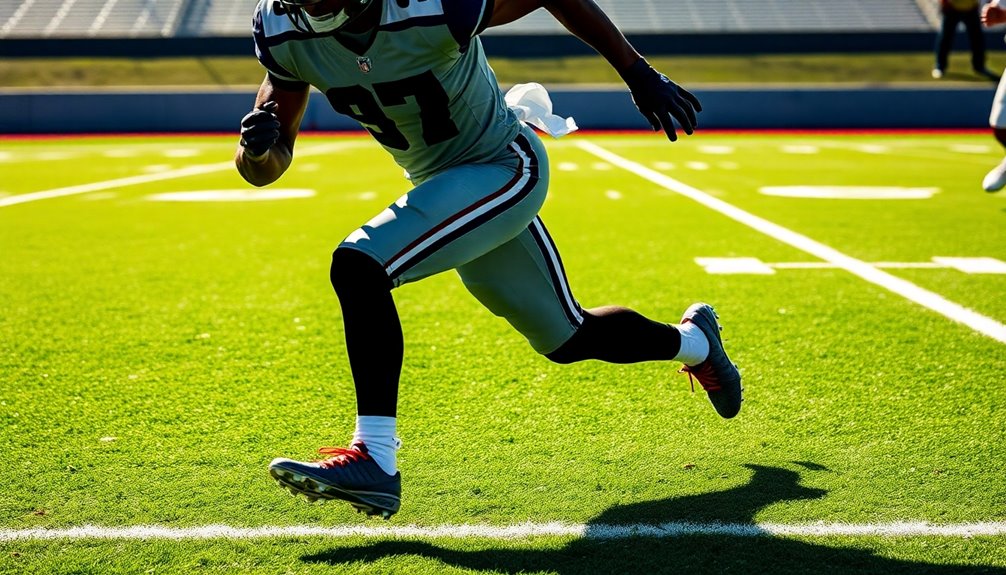
WR Routes: Essential Patterns for Wide Receivers
January 23, 2025If you want to master wide receiver routes, understanding the route tree is essential. Familiarize yourself with basic patterns like Flat, Slant, and Comeback, which are crucial for setting up plays. As you advance, focus on intermediate and deep routes like Post and Corner to stretch the defense. Utilize effective techniques, such as sharp cuts and head fakes, to create separation from defenders. Learning combinations like Dagger and Sail helps exploit defensive weaknesses. By honing these skills and concepts, you'll elevate your game. There's plenty more to explore to fully grasp route running strategies.
Overview of the Route Tree
The route tree serves as a fundamental blueprint for wide receivers, outlining the various routes they can run on the field. It's a systematic visual representation that categorizes routes by odd and even numbers, helping you quickly identify whether a route breaks out or in. Additionally, understanding the field dimensions is essential for determining the spacing required between routes during a game. A well-structured 4-4-2 formation can parallel the importance of spacing in route running, ensuring that receivers maintain proper distance to avoid clustering.
Basic routes like Flat, Slant, Comeback, Curl, and Out each have distinct purposes that fit into your overall offensive strategy.
As you advance your skills, you'll encounter more complex routes such as Corner, Post, and Fly. These deep routes require precision and timing, as they aim to penetrate the defense further down the field. Mastering these routes is vital for effective route running and creating opportunities for big plays.
You'll also need to understand route combinations like Dagger and Smash, which optimize field space. By using multiple receiver routes in tandem, you can exploit defensive weaknesses and create openings.
Strong communication with your quarterback is essential, as it allows for quick adaptations based on defensive coverage. Ultimately, a solid grasp of the route tree not only improves your performance but also enhances the overall effectiveness of your team's offensive strategy. Additionally, mastering passing accuracy is crucial for executing these routes successfully.
Basic Route Types
When you're mastering the basic route types, understanding the flat, slant, comeback, and curl routes is essential.
Each route has its unique application and effectiveness in different game situations. For example, the historical foundations of soccer, which include various kicking games, demonstrate the importance of agility and skill in athletic performance. Additionally, incorporating endurance drills can significantly improve your ability to execute these routes under pressure.
Let's break down how these routes can enhance your performance on the field. Additionally, consistent practice is crucial for refining your technical abilities and executing these routes effectively.
Flat Route Overview
Flat routes are vital tools in a receiver's arsenal, especially for slot receivers and tight ends. When you run a flat route, you execute a quick out-breaking route, typically taking three vertical steps before breaking towards the sideline. This technique is designed to create separation from defenders, allowing for a quick catch and gain.
Flat routes shine in short-yardage situations, where quarterbacks can deliver quick passes with minimal defensive pressure. To maximize the effectiveness of the flat route, it's important to maintain precise timing and communication between you and the quarterback. This guarantees that the pass reaches you just as you make your break, reducing the risk of interceptions.
Additionally, consider using flat routes in combination with other routes, such as slants or drags. This strategy can confuse the defense, making it harder for them to anticipate your movements.
Slant Route Effectiveness
Executing a slant route effectively can transform a play, offering a quick and reliable option for gaining yards. When you run a slant route, you take 1-3 steps forward before cutting inside at a 45-degree angle. This quick movement is particularly effective against tight coverage, allowing you to create separation from defensive backs.
In situations where the defense applies pressure, this route enables a fast release, making it easier for a quarterback to deliver a quick pass.
As a receiver, you need to focus on precision timing with your quarterback. The success of the slant route hinges on your ability to anticipate the throw and make your cut at just the right moment. Not only does this route work well from various positions—whether you're an outside receiver or a slot receiver—but it's also a strategic choice in offensive schemes.
Once you catch the ball, your immediate separation from defenders can lead to significant opportunities for yards after the catch (YAC). Whether you're looking to move the chains or exploit a defensive weakness, mastering the slant route can be a game-changer.
Comeback and Curl Routes
After mastering the slant route, it's time to expand your repertoire with comeback and curl routes, both of which are vital for intermediate passing success.
The comeback route involves you faking a vertical route before breaking back toward the quarterback at a 45-degree angle. Here, you'll want to utilize sideline leverage to create separation from the defender. Success hinges on precise timing between you and the quarterback, especially for those back shoulder throws that exploit defensive coverage.
On the other hand, the curl route has you running vertically before abruptly breaking inward, typically at around 10-12 yards. This allows you to turn and face the quarterback for a quick catch.
Curl routes often pair well with comeback routes in option plays, letting you read defensive coverage and adjust your break accordingly for maximum effectiveness.
Both the comeback and curl routes are essential for creating intermediate passing opportunities, making them valuable tools for quarterbacks looking to exploit zone coverage.
Mastering these routes not only enhances your skill set but also greatly contributes to your team's offensive strategy.
Intermediate and Deep Routes

When it comes to wide receiver routes, intermediate and deep options play an essential role in stretching the defense and creating big-play opportunities. The go route, for instance, emphasizes speed as you sprint downfield, aiming to create separation for significant yardage throws. In addition, the evolution of offensive strategies in basketball has parallels in football, where precise route running can lead to effective scoring plays.
In contrast, the post route allows you to attack the deep middle of the field by breaking inward at a 45-degree angle, effectively splitting defenders.
For those intermediate situations, the corner route is highly effective, as you break towards the sideline, exploiting coverages like Cover 2. This creates space and opportunities for completions.
Similarly, dig routes involve you breaking inside at a 90-degree angle, using your body to pin defenders outside, which can lead to valuable gains in the intermediate range.
Understanding route variations is vital; similar routes might've different names but serve comparable purposes.
Whether you're running a fade, fly, or steak route, attention to detail in your route running can make all the difference. Additionally, successful route running requires teamwork and strategy, as the interplay between different positions contributes to overall team success.
Route Combinations and Concepts
When you're looking to create space and confuse defenders, effective route pairing is key.
Strategic route concepts like the Dagger and Sail can stretch defenses both vertically and horizontally, giving your quarterback more options. Understanding the importance of tactical formations can also help receivers better anticipate defensive alignments and adjust their routes accordingly. Additionally, applying proper spacing in routes can further enhance a receiver's ability to find openings against defenders.
Incorporating offensive play tactics can significantly improve your team's scoring potential.
Effective Route Pairing
Combining routes effectively is essential for wide receivers to create space and confuse defenses. By mastering effective route pairing, you can exploit defensive backs and open up options for your quarterback.
For instance, the Dagger concept involves an outside receiver running an in route while the inside receiver takes a go route, clearing space for a potential deep strike.
Another great combination is the Sail concept, where the outside receiver runs vertically, stretching the defense, while the inside receiver executes an out route. This horizontal stretch can disorient defensive backs.
The Smash concept, pairing a corner route with a curl route, puts pressure on deep zone coverage, forcing defenders to make tough decisions.
To enhance your game, consider these effective route pairings:
- Slant/Slant Flat: Quick passing opportunities, perfect for soft coverage.
- Go/Post: Challenges two deep defenders, creating multiple threats.
- Dagger/Sail: Opens up the field both vertically and horizontally.
Strategic Route Concepts**
Strategic route concepts are essential for maximizing offensive effectiveness and creating mismatches against defenses. By utilizing route combinations, you can leverage the positioning of multiple receivers to exploit defensive coverage. Concepts like the Dagger and Sail pair deep routes with shorter options, creating space and challenging defenders.
One effective combination is the Smash concept, where the inside receiver runs a corner route while the outside receiver executes a curl. This stresses the outer deep zone, particularly against Cover 2 defenses.
Similarly, Slant Flat combinations allow two receivers to run quick slant routes simultaneously, generating immediate passing opportunities and testing defenders' reaction times.
When targeting Cover 2 beaters, pairing a go route with a post route can expose the vulnerabilities of the two deep defenders, attacking the middle of the field effectively.
However, to maximize separation and capitalize on defensive misalignments, timing and coordination between you and the quarterback are vital. As offensive players, mastering these strategic route concepts won't only enhance your performance but also elevate the entire offense's effectiveness on the field.
Importance of Route Running

Route running is vital for wide receivers, as it determines their ability to shake off defenders and secure receptions during games. Mastering this skill can greatly impact your effectiveness on the field. It's not just about speed; it's about creating separation through clean releases and proper footwork. Additionally, incorporating endurance training methods into your routine can improve your overall stamina and performance during games. Consistent practice of speed and agility drills can also help enhance your burst off the line.
You need to develop a keen sense of timing, both with the quarterback and the flow of the game.
Here are a few key aspects to keep in mind:
- Deceptive Movements: Use body language to make defenders think you're going one way while you cut another.
- Consistent Practice: Regularly refine your techniques to guarantee you're always prepared for different defensive coverages.
- Communication: Maintain open lines with your quarterback to enhance your timing and execution.
Continuous learning is vital. Even minor improvements in your route running can lead to better performance and more successful catches. Additionally, regularly practicing agility drills can significantly enhance your ability to change direction quickly and effectively during routes.
Techniques for Effective Routes
Mastering route running techniques is key to elevating your game on the field. A solid stance with your weight over your toes allows you to be quick and agile. For routes like slants and posts, focus on the plant and cut technique—drive off your outside foot to change direction swiftly while maintaining your speed.
When you need to stop quickly, use the breakdown technique; sink your hips to execute hitches and comebacks effectively.
Deception is essential in route running. Utilize head and shoulder fakes to mislead defenders, increasing your chances of creating separation. When running a go route, remember that detail matters. Clean releases and precise footwork can help you break free from coverage.
If you need to cut inside or break back, practice those movements until they become second nature. Additionally, understanding how to maintain possession while executing your routes can further enhance your effectiveness against defenders.
Incorporate these techniques consistently, whether you're pulling the safety or trying to catch the ball in traffic. The more you refine these basic routes, the more effective you'll be on the field.
Focus on these elements, and watch your performance soar.
Advanced Route Strategies

While you've honed your basic route running skills, integrating advanced strategies can take your game to the next level. Using combination routes like the Dagger Concept can be particularly effective. Here, the outside receiver runs an in route to clear space for the inside receiver's go route, making it harder for defenders to anticipate your movements.
In addition, employing double moves, such as the Stop N Go, can deceive defenders by faking a stop before you accelerate downfield. This unpredictability is key to creating separation.
Consider these advanced techniques to enhance your route strategies:
- Breaking the cushion: Sprint towards the defender to disrupt their positioning and create space.
- Understanding defensive alignments: Recognize weaknesses in Cover 2 and Cover 3 defenses to adjust your routes and exploit gaps.
- Utilizing the Sail Concept: Leverage vertical and out-breaking routes to challenge defenders as they cover multiple threats.
Drills for Skill Development
To elevate your game, incorporating targeted drills into your training routine can greatly enhance your skills as a wide receiver. Start with the Locate and Catch Drill, which sharpens your ability to track and catch the ball, boosting your hand-eye coordination.
Next, the High Knees to the Ball Drill emphasizes proper catching technique while running at speed, helping you develop fluidity in your movements.
The 5-Cone Roll Drill is vital for maintaining proper route depth and flatness, ensuring you execute routes with precision. It focuses on your ability to navigate through cones while keeping your routes sharp.
Another key drill is the Shute Drill, which encourages low body mechanics during route execution, promoting better balance and agility as you make cuts.
Consistent daily practice, whether on your own or with teammates, is essential for refining skills and mastering the nuances of route running.
By integrating these drills into your regimen, you'll not only improve your technical abilities but also gain confidence in your performance on the field.
Practical Applications on the Field

Executing routes effectively on the field is essential for a wide receiver's success. Mastering the route tree and understanding route numbers allows you to quickly identify your assignments during games. This enhances team coordination and keeps plays flowing smoothly.
You'll need to focus on timing and precision to create separation from defenders, especially in high-pressure situations.
Here are some key aspects to remember:
- Communication with the quarterback: Use clear route names or numbers to avoid confusion.
- Understanding defensive alignments: Adjust your routes on the fly to exploit coverage gaps.
- Consistent practice of various routes: Hone both common and advanced patterns to guarantee you're ready for any play.
Conclusion
To sum up, mastering wide receiver routes isn't just for the elite players; it's essential for anyone who wants to excel on the field. You might think it's too complex, but breaking it down into key patterns and techniques makes it manageable. With dedication and practice, you can elevate your game and create separation from defenders. So, embrace these strategies, put in the work, and watch your performance soar. The field's yours for the taking!


